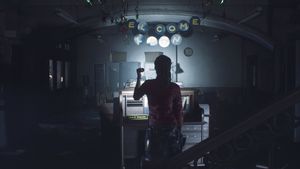JAKARTA - The entertainment industry in the Dutch colonial era was not much. Entertainment is limited to mere traditional spectacle. The current entertainment is only enjoyed by a few people. From the rich to the white. Like screenings in theaters, for example.
Films known as idoep images have become popular entertainment throughout the archipelago. However, the popularity of the film is not worth the discrimination. In cinema, Europeans are placed in first class. While the natives are in the lowest class: the goat class.
It didn't take long for the film industry to seize the Dutch East Indies market. Batavia, especially. Since its presence at the end of the 19th century, the screening of a silent film has often become a byword. Massive promotion is the reason.
This practice succeeded in making the entire population of Batavia – from the Dutch to the natives – impatient to witness the start of a new era of the entertainment industry in the Indies. Investors are also competing to build cinemas. All for the sake of seducing the big profits that the entertainment industry can promise.

Every day the film is shown, the fans are increasing. The sensation of watching a movie is able to attract the interest of other performing arts connoisseurs. Among other things, tonil, skits, and comedy. The films that are presented are also interesting. Most come from the land of Uncle Sam, United States. Many of the films made are dominated by images of shooting heroes, assassins, or playboy characters.
The audience really enjoyed the moving images of a film. This condition was created because films were still dominated by silent films. Silent films make the audience not focus on the story, but on the image. Scenes with violence become the dominant ingredient that can attract viewers.
“In the Dutch East Indies since the first silent documentary film was introduced in the late 1900s. The situation is very different from the situation in the United States. This difference lies in terms of the audience. Films in the Dutch East Indies, especially Batavia (Jakarta at that time), were not packaged for the poor or just young people.”
"To be allowed to watch, a person is very dependent on the differences in groups in society in accordance with the law of population division. There is an Oriental cinema in Batavia. There is also a cinema that shows films with different seating arrangements between natives and Europeans. Then, there is also a cinema that has a different location for male and female audiences,” said M. Sarief Arief in the book Politics of Film in the Dutch East Indies (2009).
Goat ClassThe natives are enthusiastic about waiting for the film. However, as has always been progress, the natives are often the object of discrimination. For example, when the presence of the tram. The colonial government to make classes available on the tram. The main class is obviously for the Dutch. the natives on the other hand.
They are placed with animals. That's why the carriages for the natives are often called the goat class. Not only that, in the world of watching movies, the goat class is also presented. Watching in class was definitely uncomfortable. Moreover, the class is behind the scenes. The audience, which is dominated by the natives, enjoys the film from behind.
Soekarno, when he was still studying at Hoogere Burgerschool (HBS) Surabaya in 1919-1922, also felt the pain of watching in the goat class. For him who has limited finances, nor is he a European, watching through the goat class is clearly suffering. However, he had no choice. His love for movies trumps all.

In addition, Soekarno and his friends admitted that there was a good session. They feel that their ability to read Dutch writing in reverse is increasing. The provision made them feel at home watching in the goat class. The only problem for Soekarno and his friends was watching a documentary showing a boxing match.
That said, the heavyweight boxing match was between Jack Johnson vs James J. Jeffries. It is very likely that the film is The Johnson-Jeffries Fight released in 1910. In that match, Bung Karno and his friends were confused by the actions of the two boxers attacking each other. They are confused which hand of the boxer to rely on.
“There is another cheap entertainment, namely cinema with silent films. New sound films appeared in Indonesia in the thirties. Because the audience is mute, the audience knows how to tell the story from the text highlighted on the white screen, which is normal for viewers sitting in front of the screen. But in the past, in the cinema there was also a cheaper class, namely class IV (goat class) which was located behind the scenes. The audience sat on a row of rough wooden planks. Tickets cost no more than 11 cents guilder, including 1 cent viewing tax. So, that's where we sit, including Soekarno."

“Try now to read the subtitles from behind the screen. It is not easy, because the letters are reversed. But over time this difficulty can be overcome by getting used to it. However, there is one thing that feels a bit lame. It can be seen in the film that all left-handed players write with their left hand, shake hands with their left hand, hold a spoon with their left hand, and so on,” said Herman Kartowisastro, Soekarno's close friend when he was studying at HBS in the book Special Story of Bung Karno (2010).
The English, Chinese, Japanese, Arabic, and French versions are automatically generated by the AI. So there may still be inaccuracies in translating, please always see Indonesian as our main language. (system supported by DigitalSiber.id)













